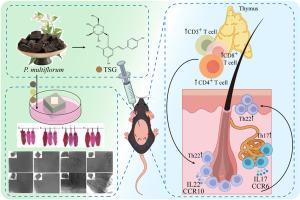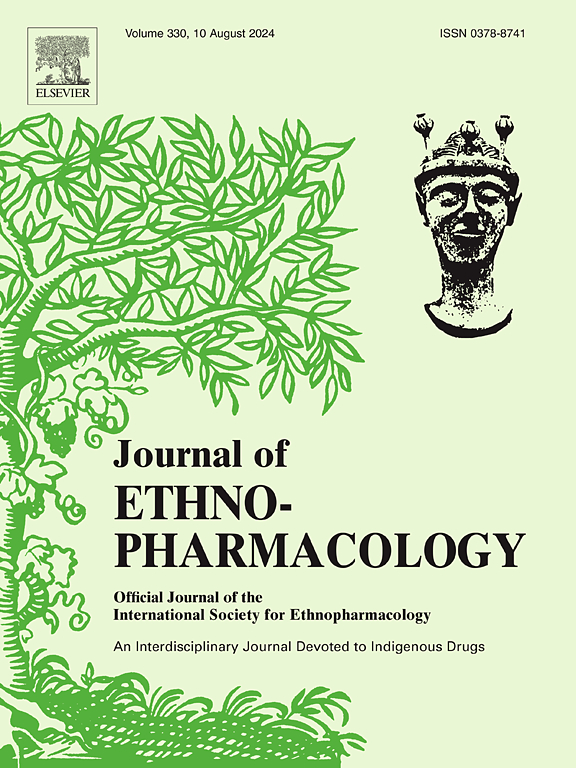Tetrahydroxy stilbene glucoside promotes hair regeneration by inducing Th22 cell differentiation
IF 5.4
2区 医学
Q1 CHEMISTRY, MEDICINAL
引用次数: 0
Abstract
Ethnopharmacological relevance
Hair plays an important roles in both local protection and information transmission. But as a widespread problem, the existing therapies of hair loss are limited. 2,3,5,4′-Tetrahydroxystilbene-2-O-β-D-Glucoside (Tetrahydroxy stilbene glucoside, TSG) is the main active compound of a hair promoting herb, Polygonum multiflorum Thunb., that has been used in China for over 1000 years. However, its role and mechanism of action remain unclear.
Aim of the study
To investigate the promoting effect of TSG on hair growth and elucidate the mechanism by which TSG affects hair regeneration via Th22.
Materials and methods
Mouse skin explants and 3D ex vivo culture systems were employed to screen substances of P. multiflorum for promoting hair growth. The hair regeneration effect of TSG was explored via mice model by subcutaneous injection. The changes of biological dynamics, hair regeneration, histomorphology of skin, and morphology of hair follicle were observed. T cell subsets in peripheral blood was analyzed by Flow cytometry. Network pharmacology was used to predict the mechanism of TSG, immunohistochemistry and immunofluorescence staining were used to analyzed the distribution of T cell subsets around hair follicles. IL-22BP was used to verify the role of Th22 cells in TSG regulating hair regeneration in mice.
Results
Ex vivo organ experiments showed that compared with emodin and catechol, TSG could effectively promote the process of hair follicle transition from telogen to anagen, and make them rapidly proliferate and differentiate into hair matrix. TSG accelerated the hair growth in mice, increased the number of hair follicles and the proportion of CD4+ T cells in peripheral blood, unregulated the expression of CCR10 (Th22 marker) in the hair root sheath of hair follicle. Network pharmacology suggested TSG treatment was associated with T cell differentiation related signaling pathways, it could facilitated the differentiation and development of T cells around hair follicles, driving their transition to the Th22 subtype. IL-22BP confirmed that IL-22 secreted by activated Th22 cells is the key factor mediating hair regeneration promoted by TSG, which indirectly verifies that Th22 cells are the effector cells responsible for TSG-induced hair regeneration.
Conclusions
TSG accelerates the growth of mice hair follicles and promoting the regeneration of hair follicles by regulating the distribution and immune homeostasis of T cell subsets around hair follicles and promoting the differentiation and development of Th22 cells.

四羟基二苯乙烯苷通过诱导Th22细胞分化促进毛发再生
毛发在局部保护和信息传递中具有重要作用。但作为一个普遍存在的问题,现有的治疗脱发的方法是有限的。2,3,5,4 ' -四羟基二苯乙烯-2- o -β- d -葡萄糖苷(Tetrahydroxy stilbene glucoside, TSG)是一种生发草本植物何首乌的主要活性化合物。这在中国已经使用了1000多年。然而,其作用和作用机制尚不清楚。目的研究TSG对头发生长的促进作用,阐明TSG通过Th22影响头发再生的机制。材料与方法采用小鼠皮肤外植体和3D离体培养系统筛选何首花促进毛发生长的物质。通过小鼠皮下注射,探讨TSG对小鼠毛发再生的作用。观察生物动力学、毛发再生、皮肤组织形态学和毛囊形态的变化。流式细胞术分析外周血T细胞亚群。应用网络药理学预测TSG作用机制,应用免疫组织化学和免疫荧光染色分析毛囊周围T细胞亚群分布。利用IL-22BP验证Th22细胞在TSG调节小鼠毛发再生中的作用。结果与大黄素和儿茶酚相比,TSG能有效促进毛囊从休止期向生长期过渡,使毛囊快速增殖分化为毛基质。TSG促进小鼠毛发生长,增加毛囊数量和外周血CD4+ T细胞比例,调节毛囊毛根鞘中CCR10 (Th22标记物)的表达。网络药理学提示TSG治疗与T细胞分化相关的信号通路有关,可以促进毛囊周围T细胞的分化发育,推动其向Th22亚型转变。IL-22BP证实了活化的Th22细胞分泌的IL-22是介导TSG促进毛发再生的关键因子,间接证实了Th22细胞是TSG诱导毛发再生的效应细胞。结论stsg通过调节毛囊周围T细胞亚群的分布和免疫稳态,促进Th22细胞的分化发育,促进小鼠毛囊的生长,促进毛囊的再生。
本文章由计算机程序翻译,如有差异,请以英文原文为准。
求助全文
约1分钟内获得全文
求助全文
来源期刊

Journal of ethnopharmacology
医学-全科医学与补充医学
CiteScore
10.30
自引率
5.60%
发文量
967
审稿时长
77 days
期刊介绍:
The Journal of Ethnopharmacology is dedicated to the exchange of information and understandings about people''s use of plants, fungi, animals, microorganisms and minerals and their biological and pharmacological effects based on the principles established through international conventions. Early people confronted with illness and disease, discovered a wealth of useful therapeutic agents in the plant and animal kingdoms. The empirical knowledge of these medicinal substances and their toxic potential was passed on by oral tradition and sometimes recorded in herbals and other texts on materia medica. Many valuable drugs of today (e.g., atropine, ephedrine, tubocurarine, digoxin, reserpine) came into use through the study of indigenous remedies. Chemists continue to use plant-derived drugs (e.g., morphine, taxol, physostigmine, quinidine, emetine) as prototypes in their attempts to develop more effective and less toxic medicinals.
 求助内容:
求助内容: 应助结果提醒方式:
应助结果提醒方式:


